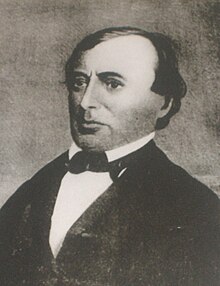Charles Bent
| Charles Bent | |
|---|---|

|
|
| Governor of New Mexico | |
|
In office September 1846 – 19 January 1847 |
|
| Preceded by | Juan Bautista Vigil y Alarid (last governor of Mexican period of New Mexico) |
| Succeeded by | Donaciano Vigil |
| Personal details | |
| Born | November 11, 1799 Charleston, Virginia, present-day Charleston, West Virginia |
| Died | January 19, 1847 (aged 47) Taos, Santa Fe Territory, Mexico |
| Resting place | Santa Fe National Cemetery, Santa Fe, New Mexico |
| Nationality | American |
| Spouse(s) | Maria Ignacia Jaramillo |
| Parents | Silas Bent |
| Relatives | William Bent |
| Occupation | fur trader, soldier, sutler |
Charles Bent (November 11, 1799 – January 19, 1847) was appointed as the first civilian Governor of the newly acquired New Mexico Territory by military Governor Stephen Watts Kearny in September 1846.
Charles Bent had been working as a fur trader in the region since 1828, with his younger brother, William and later partner Ceran St. Vrain. Though his office was in Santa Fe, Bent maintained his residence and a trading post in Taos, New Mexico Territory, now in present-day New Mexico. On January 19, 1847, Charles Bent was scalped and killed by Pueblo warriors, during the Taos Revolt.
Charles Bent was born in Charleston, Virginia, the oldest child of Silas Bent and his wife.
After leaving the army, in 1828, Charles and his younger brother, William, took a wagon train of goods from St. Louis to Santa Fe. There they established mercantile contacts and began a series of trading trips back and forth over the Santa Fe Trail. In 1832, he formed a partnership with Ceran St. Vrain, another trader from St. Louis, called Bent & St. Vrain Company. In addition to its store in Taos, New Mexico, the trading company established a series of "forts", fortified trading posts, to facilitate trade with the Plains Indians, including Fort Saint Vrain on the South Platte River and Bent's Fort on the Arkansas River, both in Colorado; and Fort Adobe on the Canadian River. Bent's Fort, outside La Junta, Colorado, has been restored and is now a National Historic Site.
...
Wikipedia
